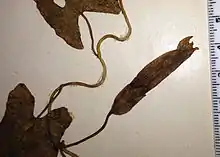Caroline Bingham
Caroline Priscilla Bingham (née Lord, 1831–1932) was an American botanist who was one of the earliest American women to publish scientific papers on botany. She was an influential collector of botanical specimens discovering a new genus and several new species. As a result of her discoveries Bingham had a genus and several algae species named in her honor.[1]
Caroline Priscilla Bingham | |
|---|---|
| Nationality | American |
| Known for | Discovery of several new species of algae |
| Scientific career | |
| Fields | Botanist |

Biography
Early life and marriage
Bingham was born in 1831 in Pennsylvania. She and her family shifted to Ohio around 1836. She married her husband, Richard Fitch Bingham in Ohio and subsequently the couple moved to California in 1873. At around this time she took up the study of botany.[2]
Botany work
Bingham was one of the earliest American women to publish a scientific paper on botany. She is one of only six American women listed in the London Royal Society Catalogue of Science Papers 1800 - 1900 whose journal articles pre date 1880.[3] Her first known article was published in the Botanical Gazette in 1879.[4]
Bingham was a member of the Santa Barbara Natural History Society and held the position of Secretary of the Society.[5] She was also a member of the publication committee for the Bulletin of the Santa Barbara Society and published an article in that journal in March 1887.[6]
As well as publishing papers on her botany work Bingham collaborated with botanists such as Alpheus Hervey, William Gilson Farlow[8] and Jacob Georg Agardh.[8] Bingham assisted their work by providing specimens, lists of plants she collected, notes on special habitat, seasons of growth and frequency of appearance.
Bingham also corresponded with Joseph Dalton Hooker at the Royal Botanical Gardens, Kew on botanical matters.[9]
Her specimens continue to be studied[10] and are held at various herbaria including the United States National Herbarium,[11] the Gray Herbarium, the Steere Herbarium of the New York Botanical Garden, the University of Notre Dame herbarium, the University of California herbarium, the California Academy of Sciences herbarium and the Farlow Herbarium at Harvard University[12]
Death
Her husband died in 1895 and she subsequently moved to New Bedford where she died aged 101.
Published works
- Bingham, R. F., (1879), "Common and troublesome weeds near Santa Barbara", California Botanical Gazette, Vols 3 and 4, p. 226
- Bingham, R. F. (1887). "Flora near Santa Barbara". California Botanical Gazette. 12 (2): 33–35. doi:10.1086/326074.
- Bingham, R. F. (1887). "An American Papaver". California Botanical Gazette. 12 (3): 67. doi:10.1086/326091.
- Bingham, R. F. (1890). "Medicinal Plants growing wild in Santa Barbara and vicinity". Bulletin of the Santa Barbara Society of Natural History. 1 (2): 34–37.
Eponymous taxa
Bingham had the algal genus Binghamia named after her along with several algae species including Dictyota binghamiae, Endarachne binghamiae, Gigartina binghamiae and Leptocladia binghamiae[1][2]
References
- Hollenberg, George J.; Abbott, Isabella A. (1992). Marine Algae of California. Stanford, California: Stanford University Press. p. 24. ISBN 9780804721523.
- Charters, Michael L. "bing'hamiae". www.calfora.net. Retrieved April 30, 2015.
- Creese, Mary R. S. (1998). Ladies in the laboratory? : American and British women in science, 1800-1900 : a survey of their contributions to research. Lanham, Md.: Scarecrow. p. 3. ISBN 081083287-9.
- Gray, A. (1879). "Common and troublesome weeds near Santa Barbara". Botanical Gazette. IV (11): 226. doi:10.1086/325297. Retrieved April 30, 2015.
- "Scientific Societies of California". The West-American Scientist. 1 (10): 75. 1885. Retrieved April 30, 2015.
- Bingham, R. F., Mrs (March 1887). "Flora Near Santa Barbara California". Bulletin of the Santa Barbara Society of Natural History. 1: 18–21. Retrieved April 30, 2015.
- Setchell, W. A.; Dawson, E. Y. (1941). "Binghamia, the Alga, versus Bighamia, the Cactus". Proceedings of the National Academy of Sciences of the United States of America. 27 (8): 376–381. Bibcode:1941PNAS...27..376S. doi:10.1073/pnas.27.8.376. PMC 1078343. PMID 16588473.
- "Letter from Mrs R.F. Bingham to Sir Joseph Dalton Hooker; from Santa Barbara, California, United States of America; 3 Nov 1885; two page letter comprising two images; folio 54". JSTOR Global Plants. Royal Botanical Gardens, Kew. Retrieved May 1, 2015.
- Brummitt, R. K.; White, Scott D.; Wood, Justin M. (January 2012). "Status of Bingham's Morning-Glory in the Light of its Rediscovery". Madroño. 59: 25–27. doi:10.3120/0024-9637-59.1.25. S2CID 85731112.
- "Search of Botany Collections". Smithsonian Museum of Natural History. Smithsonian Institution. Retrieved May 1, 2015.
- "Catalog #: FH00777061". Macroalgae Herbarium Portal. Harvard University. Retrieved May 1, 2015.